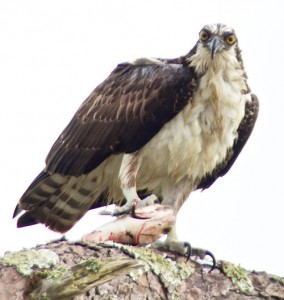 On a recent visit to Jekyll Island, we saw this Osprey (Pandion haliaetus) perching on a branch. It was holding a recently-caught fish in its talons. When we stopped the car to take a photograph, we got this baleful look. Looking directly at its face shows how its eyes are directed forward, which gives it excellent binocular vision and hence depth perception. To catch fish, which typically make up 99% of an Osprey’s diet, the birds flap or soar over water. When a fish is spotted, the bird hovers briefly before plunging toward the water. Just before entering the water, the Osprey swings its wings backward and its feet forward. Ospreys have long talons on their feet, and they can direct two toes forward and two backwards for fishing. Their success rate is usually very high, studies report fish being caught on 25 to 70 percent of dives. Other adaptations for fishing include spiny footpads, long legs, nasal valves to keep out water during dives, and a dense, oily suit of feathers.
On a recent visit to Jekyll Island, we saw this Osprey (Pandion haliaetus) perching on a branch. It was holding a recently-caught fish in its talons. When we stopped the car to take a photograph, we got this baleful look. Looking directly at its face shows how its eyes are directed forward, which gives it excellent binocular vision and hence depth perception. To catch fish, which typically make up 99% of an Osprey’s diet, the birds flap or soar over water. When a fish is spotted, the bird hovers briefly before plunging toward the water. Just before entering the water, the Osprey swings its wings backward and its feet forward. Ospreys have long talons on their feet, and they can direct two toes forward and two backwards for fishing. Their success rate is usually very high, studies report fish being caught on 25 to 70 percent of dives. Other adaptations for fishing include spiny footpads, long legs, nasal valves to keep out water during dives, and a dense, oily suit of feathers.
According to the Cornell Lab of Ornithology, the name Osprey has its origin either in Medieval Latin “avis prede” which means “bird of prey” or in the Latin “ossifragus” which means “bone-breaker”. The generic name “Pandion” is that of a mythical Greek king. The specific name “haliaetus” means “sea eagle” in Greek. Ospreys are found in many areas across the globe, from North America and the Caribbean, across Europe, Africa, and India to Australia.
Osprey populations were reduced up to 90% in North America during the time when DDT was in wide use. DDT was banned in the U.S. about 1970, and in one of the great conversation stories of the 20th century, Osprey populations in the U.S. have rebounded to near pre-DDT levels.
